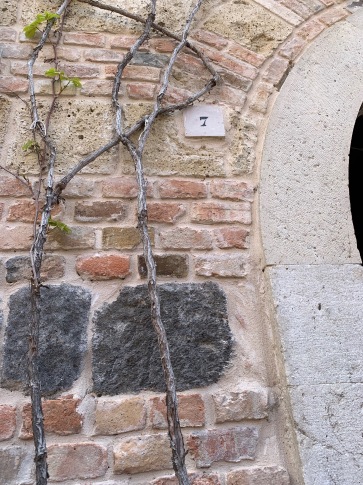On a recent trip to taste Aglianico del Vulture, I discovered the birthplace of Horace, that fun-loving Latin poet who coined the phrase Carpe diem! Or Seize the day! My suggestion: take his advice and hurry up and visit the region of Basilicata.
The lovely piazza dedicated to the monumental poet, Horace, in his birthplace, Venosa
Basilicata may be the most up-and-coming region of Italy: in 2019, its second-largest city, Matera, is the European Capital of Culture. That’s a boon to tourism, which is exactly what this small, agricultural region needs.
Several were the back-to-the-future moments where a piazza, a doorway, a quiet street, made me think of Italy back in the 1980s… If we got some vintage cars, it could look like the ‘40s or ‘50s. In other words, a place where time has stood still, in the best sense.
Layers of history were evident in the architecture – from prehistoric grottoes, to the Roman times and archeological sites, to medieval churches, on up to the present day.

The goal of my trip – as if one needed a goal to travel through il Bel Paese – was to visit the historic winery Armando Martino where Carolin Martino is the new, fresh face of the company.
Yours truly with Carolin Martino (right)
And speaking of fresh faces, Carolin also produces a line of cosmetics based on, you guessed it!, wine and grape seeds. Lovely!

The Vulture looms in the distance no matter where you go in this area, reminding you of its importance, which is evident in the wines of this region. Until very recently, there were only 4 producers, one of which was Martino Vini, and a few cantine sociali (cooperatives). Then the laws changed in 2000, and now there are 70 wine producers in Basilicata.

At the winery, it was bottling time. Love the rhythmic sound of those machines. Take a look:
They are stocking 6500 HL here in cement underground. The use of steel and wood came later, even if the trend is to return to cement, where that was the traditional method.
Underground cement tanks (left)
As you might imagine with a grape like Aglianico, with its aggressive tannins, it’s a late harvester, end of October or even early November. Harvesting is done by hand – what else? – in this hilly, rugged terrain. The surrounding area, where the Aglianico grapes grow features the grottoes, or little natural caves in the tufo hills that were one homes, animal shelters, and yes, wine cellars!


The volcanic stone – both in its black and white versions – was used to build the cellar.
I’ve already written about the rosé version of this wine (read here), but just for the record, the whites are also delicious: Martino grows Greco and Chardonnay. The Greco is delightfully aromatic and fresh, perfect for aperitif or fish dishes.
And the food? Hearty, healthy, with a lot of crusco peppers everywhere. Tasty, not spicey!
When Carolin isn’t busy running a winery and producing cosmetics, she finds the time to do things like represent her region as the Delegate to the national association of the Women of Wine, or even head the DOCG consortium during its first year. No grass grows under this lady’s feet!
A very picturesque moment, under a Renaissance vaulted ceiling with lanterns!















Leave a comment